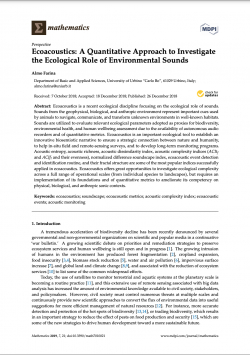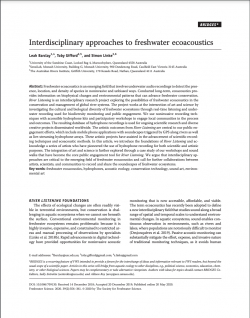An Exploration of Ecoacoustics and its Applications in Conservation Ecology

Type
Journal
Authors
Category
Article
[ Browse Items ]
Publication Year
2024
Publisher
URL
[ private ]
Pages
105296
Tags
Abstract
Our planet is facing unprecedented adversity due to the global impacts of climate change and an emerging sixth mass extinction. These impacts are exacerbated by population and industrial growth, where increased resource extraction is required to meet our insatiable demands. Yet, the tangible elements of our lone inhabited planet in the solar system are not the only things disappearing or being modified. The sounds of Earth are being altered in ways that may never be recovered. Indeed, we occupy a noisier world in this age of machines that comes at a great expense in the form of sonic extinctions. It is profoundly apparent, yet not widely recognized, that conservation efforts must consider the importance of the sonic environment (i.e., sonosphere). Although sound has been integral to life for millions of years, our understanding of its ecological role has only just begun. Sounds are one of the most important extensions of the organismic inner world, becoming testimonials of environmental complexity, integration, and relationships between apparently separated parts. From a semiotic perspective, sounds are signals utilized by many organisms to save energy in patrolling, defending, exploring, and navigating their surroundings. Sounds are tools that establish dynamic biological and ecological competencies through refined partitioning in the natural selection process of evolution. Ecoacoustics is a recent scientific discipline that aims to investigate the role of sound in ecological processes. Despite its youth, Ecoacoustics has had rapid theoretical and applied growth, consolidating a diverse array of research on the ecology of sounds across many disciplines. Here, we present how Ecoacoustics plays a significant role in conservation ecology by exploring the discipline’s theoretical framework, new descriptors of sonic complexity, and innovative methods for supporting conservation efforts for singular species to entire landscapes across local and global scales. The combination of autonomous recording devices and ecoacoustic indices present a very promising approach to the study of remote areas, rare species, and data rich analyses. While Ecoacoustics scientists continue to explore this new scientific horizon, we encourage others to consider Ecoacoustics in their conservation agendas because of its application to the study and management of terrestrial, marine, and freshwater habitats.
Description
https://www.sciencedirect.com/science/article/pii/S0303264724001813
Number of Copies
1
| Library | Accession No | Call No | Copy No | Edition | Location | Availability |
|---|---|---|---|---|---|---|
| Main | 758 | 1 | Yes |


